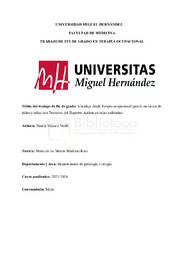Please use this identifier to cite or link to this item:
https://hdl.handle.net/11000/33197Full metadata record
| DC Field | Value | Language |
|---|---|---|
| dc.contributor.advisor | Martínez Ruiz, María de las Nieves | - |
| dc.contributor.author | Velasco Verdú, Noelia | - |
| dc.contributor.other | Departamentos de la UMH::Patología y Cirugía | es_ES |
| dc.date.accessioned | 2024-09-18T06:38:11Z | - |
| dc.date.available | 2024-09-18T06:38:11Z | - |
| dc.date.created | 2024-04-25 | - |
| dc.identifier.uri | https://hdl.handle.net/11000/33197 | - |
| dc.description.abstract | El presente trabajo se trata de una guía informativa para los docentes de colegios, cuyo principal objetivo es dar a conocer la figura de laTerapia Ocupacional en la escuela y por consiguiente en informar a los profesionales de los centros escolares sobre posibles adaptaciones y estrategias que se pueden implementar en el aula, teniendo en cuenta la presencia de niños y niñas con Trastorno del Espectro Autista en aulas ordinarias. Se hace referencia a los diferentes problemas sensoriales que pueden darse en este colectivo de niños/as, los cuales repercuten en la conducta en el aula y por consiguiente en el rendimiento académico. Es por ello, que esta guía va dedicada afavorecer la inclusión de niños y niñas con Trastorno del Espectro Autista en el aula y en los diferentes espacios del colegio, como son los pasillos, el aseo, el recreo y el comedor, así como proporcionar estrategias para actuar frente a posibles situaciones, adaptar el entorno y el material, estructurar el aula e implementar rutinas para entrenar habilidades y potenciar la autonomía de los alumnos/as en el entorno escolar. | es_ES |
| dc.description.abstract | The present work is an informative guide for school teachers, whose main objective is to introduce the figure of Occupational Therapy in the school and consequently to inform professionals in school settings about possible adaptations and strategies tha tcan be implemented in the classroom, taking into account the presence of children with Autism Spectrum Disorder in ordinary classrooms. Reference is made to the different sensory issues that may arise in this group of children, which affect behavior in the classroom and consequently academic performance. Therefore, this guide is dedicated to promoting the inclusion of children with Autism Spectrum Disorder in the classroom and in different areas of the school, such as hallways, bathrooms, playground and the school canteen, as well as providing strategies to address possible situations, adapt the environment and materials, structure the classroom, and implement routines to train skills and enhance the autonomy of students in the school environment. | es_ES |
| dc.format | application/pdf | es_ES |
| dc.format.extent | 103 | es_ES |
| dc.language.iso | spa | es_ES |
| dc.publisher | Universidad Miguel Hernández | es_ES |
| dc.rights | info:eu-repo/semantics/openAccess | es_ES |
| dc.rights.uri | http://creativecommons.org/licenses/by-nc-nd/4.0/ | * |
| dc.subject | Trastorno del Espectro Autista | es_ES |
| dc.subject | terapia ocupacional | es_ES |
| dc.subject | procesamiento sensorial | es_ES |
| dc.subject | inclusión | es_ES |
| dc.subject | escuela | es_ES |
| dc.subject | Autism Spectrum Disorder | es_ES |
| dc.subject | occupational therapy | es_ES |
| dc.subject | sensory processing | es_ES |
| dc.subject | inclusion | es_ES |
| dc.subject | school | es_ES |
| dc.subject.other | CDU::6 - Ciencias aplicadas | es_ES |
| dc.title | Abordaje desde Terapia ocupacional para la inclusión de niños y niñas con Trastorno del Espectro Autista en aulas ordinarias | es_ES |
| dc.type | info:eu-repo/semantics/bachelorThesis | es_ES |

View/Open:
TFG NOELIA VELASCO VERDÚ .pdf
44,24 MB
Adobe PDF
Share:
.png)
